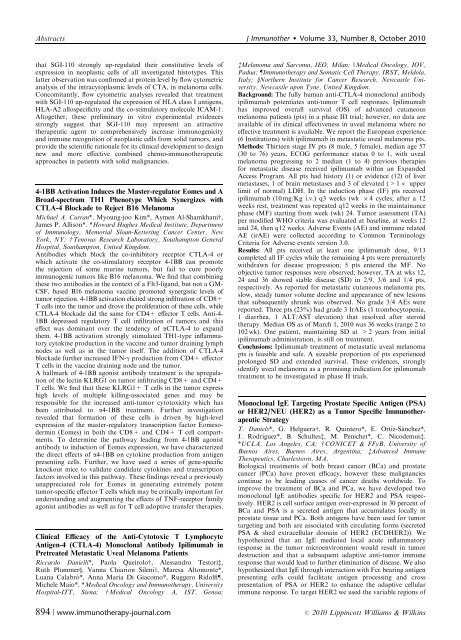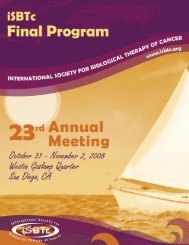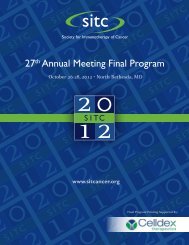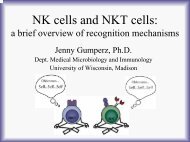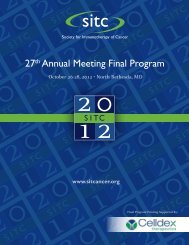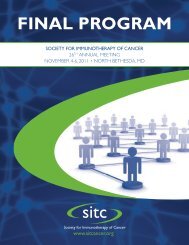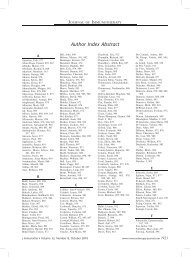Abstracts for the 25th Annual Scientific Meeting of the International ...
Abstracts for the 25th Annual Scientific Meeting of the International ...
Abstracts for the 25th Annual Scientific Meeting of the International ...
Create successful ePaper yourself
Turn your PDF publications into a flip-book with our unique Google optimized e-Paper software.
<strong>Abstracts</strong> J Immuno<strong>the</strong>r Volume 33, Number 8, October 2010<br />
that SGI-110 strongly up-regulated <strong>the</strong>ir constitutive levels <strong>of</strong><br />
expression in neoplastic cells <strong>of</strong> all investigated histotypes. This<br />
latter observation was confirmed at protein level by flow cytometric<br />
analysis <strong>of</strong> <strong>the</strong> intracytoplasmic levels <strong>of</strong> CTA, in melanoma cells.<br />
Concomitantly, flow cytometric analyses revealed that treatment<br />
with SGI-110 up-regulated <strong>the</strong> expression <strong>of</strong> HLA class I antigens,<br />
HLA-A2 allospecificity and <strong>the</strong> co-stimulatory molecule ICAM-1.<br />
Altoge<strong>the</strong>r, <strong>the</strong>se preliminary in vitro experimental evidences<br />
strongly suggest that SGI-110 may represent an attractive<br />
<strong>the</strong>rapeutic agent to comprehensively increase immunogenicity<br />
and immune recognition <strong>of</strong> neoplastic cells from solid tumors, and<br />
provide <strong>the</strong> scientific rationale <strong>for</strong> its clinical development to design<br />
new and more effective combined chemo-immuno<strong>the</strong>rapeutic<br />
approaches in patients with solid malignancies.<br />
4-1BB Activation Induces <strong>the</strong> Master-regulator Eomes and A<br />
Broad-spectrum TH1 Phenotype Which Synergizes with<br />
CTLA-4 Blockade to Reject B16 Melanoma<br />
Michael A. Curran*, Myoung-joo Kim*, Aymen Al-Shamkhaniw,<br />
James P. Allison*. *Howard Hughes Medical Institute, Department<br />
<strong>of</strong> Immunology, Memorial Sloan-Kettering Cancer Center, New<br />
York, NY; w Tenovus Research Laboratory, Southampton General<br />
Hospital, Southampton, United Kingdom.<br />
Antibodies which block <strong>the</strong> co-inhibitory receptor CTLA-4 or<br />
which activate <strong>the</strong> co-stimulatory receptor 4-1BB can promote<br />
<strong>the</strong> rejection <strong>of</strong> some murine tumors, but fail to cure poorly<br />
immunogenic tumors like B16 melanoma. We find that combining<br />
<strong>the</strong>se two antibodies in <strong>the</strong> context <strong>of</strong> a Flt3-ligand, but not a GM-<br />
CSF, based B16 melanoma vaccine promoted synergistic levels <strong>of</strong><br />
tumor rejection. 4-1BB activation elicited strong infiltration <strong>of</strong> CD8+<br />
T cells into <strong>the</strong> tumor and drove <strong>the</strong> proliferation <strong>of</strong> <strong>the</strong>se cells, while<br />
CTLA-4 blockade did <strong>the</strong> same <strong>for</strong> CD4+ effector T cells. Anti-4-<br />
1BB depressed regulatory T cell infiltration <strong>of</strong> tumors and this<br />
effect was dominant over <strong>the</strong> tendency <strong>of</strong> aCTLA-4 to expand<br />
<strong>the</strong>m. 4-1BB activation strongly stimulated TH1-type inflammatory<br />
cytokine production in <strong>the</strong> vaccine and tumor draining lymph<br />
nodes as well as in <strong>the</strong> tumor itself. The addition <strong>of</strong> CTLA-4<br />
blockade fur<strong>the</strong>r increased IFN-g production from CD4+ effector<br />
T cells in <strong>the</strong> vaccine draining node and <strong>the</strong> tumor.<br />
A hallmark <strong>of</strong> 4-1BB agonist antibody treatment is <strong>the</strong> upregulation<br />
<strong>of</strong> <strong>the</strong> lectin KLRG1 on tumor infiltrating CD8+ and CD4+<br />
T cells. We find that <strong>the</strong>se KLRG1+ T cells in <strong>the</strong> tumor express<br />
high levels <strong>of</strong> multiple killing-associated genes and may be<br />
responsible <strong>for</strong> <strong>the</strong> increased anti-tumor cytotoxicity which has<br />
been attributed to a4-1BB treatment. Fur<strong>the</strong>r investigation<br />
revealed that <strong>for</strong>mation <strong>of</strong> <strong>the</strong>se cells is driven by high-level<br />
expression <strong>of</strong> <strong>the</strong> master-regulatory transcription factor Eomesodermin<br />
(Eomes) in both <strong>the</strong> CD8+ and CD4+ T cell compartments.<br />
To determine <strong>the</strong> pathway leading from 4-1BB agonist<br />
antibody to induction <strong>of</strong> Eomes expression, we have characterized<br />
<strong>the</strong> direct effects <strong>of</strong> a4-1BB on cytokine production from antigen<br />
presenting cells. Fur<strong>the</strong>r, we have used a series <strong>of</strong> gene-specific<br />
knockout mice to validate candidate cytokines and transcription<br />
factors involved in this pathway. These findings reveal a previously<br />
unappreciated role <strong>for</strong> Eomes in generating extremely potent<br />
tumor-specific effector T cells which may be critically important <strong>for</strong><br />
understanding and augmenting <strong>the</strong> effects <strong>of</strong> TNF-receptor family<br />
agonist antibodies as well as <strong>for</strong> T cell adoptive transfer <strong>the</strong>rapies.<br />
Clinical Efficacy <strong>of</strong> <strong>the</strong> Anti-Cytotoxic T Lymphocyte<br />
Antigen-4 (CTLA-4) Monoclonal Antibody Ipilimumab in<br />
Pretreated Metastatic Uveal Melanoma Patients<br />
Riccardo Danielli*, Paola Queirolow, Alessandro Testoriz,<br />
Ruth Plummery, Vanna Chiarion SileniJ, Maresa Altomonte*,<br />
Luana Calabro´ *, Anna Maria Di Giacomo*, Ruggero Ridolfiz,<br />
Michele Maio*. *Medical Oncology and Immuno<strong>the</strong>rapy, University<br />
Hospital-ITT, Siena; w Medical Oncology A, IST, Genoa;<br />
zMelanoma and Sarcoma, IEO, Milan; JMedical Oncology, IOV,<br />
Padua; zImmuno<strong>the</strong>rapy and Somatic Cell Therapy, IRST, Meldola,<br />
Italy; yNor<strong>the</strong>rn Institute <strong>for</strong> Cancer Research, Newcastle University,<br />
Newcastle upon Tyne, United Kingdom.<br />
Background: The fully human anti-CTLA-4 monoclonal antibody<br />
ipilimumab potentiates anti-tumor T cell responses. Ipilimumab<br />
has improved overall survival (OS) <strong>of</strong> advanced cutaneous<br />
melanoma patients (pts) in a phase III trial; however, no data are<br />
available <strong>of</strong> its clinical effectiveness in uveal melanoma where no<br />
effective treatment is available. We report <strong>the</strong> European experience<br />
(6 Institutions) with ipilimumab in metastatic uveal melanoma pts.<br />
Methods: Thirteen stage IV pts (8 male, 5 female), median age 57<br />
(30 to 76) years, ECOG per<strong>for</strong>mance status 0 to 1, with uveal<br />
melanoma progressing to 2 median (1 to 4) previous <strong>the</strong>rapies<br />
<strong>for</strong> metastatic disease received ipilimumab within an Expanded<br />
Access Program. All pts had history (1) or evidence (12) <strong>of</strong> liver<br />
metastases, 1 <strong>of</strong> brain metastases and 3 <strong>of</strong> elevated (>1 upper<br />
limit <strong>of</strong> normal) LDH. In <strong>the</strong> induction phase (IF) pts received<br />
ipilimumab (10 mg/Kg i.v.) q3 weeks (wk 4 cycles; after a 12<br />
weeks rest, treatment was repeated q12 weeks in <strong>the</strong> maintainance<br />
phase (MF) starting from week (wk) 24. Tumor assessment (TA)<br />
per modified WHO criteria was evaluated at baseline, at weeks 12<br />
and 24, <strong>the</strong>n q12 weeks. Adverse Events (AE) and immune related<br />
AE (irAE) were collected according to Common Terminology<br />
Criteria <strong>for</strong> Adverse events version 3.0.<br />
Results: All pts received at least one ipilimumab dose, 9/13<br />
completed all IF cycles while <strong>the</strong> remaining 4 pts were prematurely<br />
withdrawn <strong>for</strong> disease progression; 5 pts entered <strong>the</strong> MF. No<br />
objective tumor responses were observed; however, TA at wks 12,<br />
24 and 36 showed stable disease (SD) in 2/9, 3/6 and 1/4 pts,<br />
respectively. As reported <strong>for</strong> metastatic cutaneous melanoma pts,<br />
slow, steady tumor volume decline and appearance <strong>of</strong> new lesions<br />
that subsequently shrunk was observed. No grade 3/4 AEs were<br />
reported. Three pts (23%) had grade 3 IrAEs (1 trombocytopenia,<br />
1 diarrhea, 1 ALT/AST elevation) that resolved after steroid<br />
<strong>the</strong>rapy. Median OS as <strong>of</strong> March 1, 2010 was 36 weeks (range 2 to<br />
102 wk). One patient, maintaining SD at >2 years from initial<br />
ipilimumab administration, is still on treatment.<br />
Conclusions: Ipilimumab treatment <strong>of</strong> metastatic uveal melanoma<br />
pts is feasible and safe. A sizeable proportion <strong>of</strong> pts experienced<br />
prolonged SD and extended survival. These evidences, strongly<br />
identify uveal melanoma as a promising indication <strong>for</strong> ipilimumab<br />
treatment to be investigated in phase II trials.<br />
Monoclonal IgE Targeting Prostate Specific Antigen (PSA)<br />
or HER2/NEU (HER2) as a Tumor Specific Immuno<strong>the</strong>rapeutic<br />
Strategy<br />
T. Daniels*, G. Helgueraw, R. Quintero*, E. Ortiz-Sánchez*,<br />
J. Rodríguez*, B. Schultesz, M. Penichet*, C. Nicodemusz.<br />
*UCLA, Los Angeles, CA; w CONICET & FFyB, University <strong>of</strong><br />
Buenos Aires, Buenos Aires, Argentina; zAdvanced Immune<br />
Therapeutics, Charlestown, MA.<br />
Biological treatments <strong>of</strong> both breast cancer (BCa) and prostate<br />
cancer (PCa) have proven efficacy, however <strong>the</strong>se malignancies<br />
continue to be leading causes <strong>of</strong> cancer deaths worldwide. To<br />
improve <strong>the</strong> treatment <strong>of</strong> BCa and PCa, we have developed two<br />
monoclonal IgE antibodies specific <strong>for</strong> HER2 and PSA respectively.<br />
HER2 is cell surface antigen over-expressed in 30 percent <strong>of</strong><br />
BCa and PSA is a secreted antigen that accumulates locally in<br />
prostate tissue and PCa. Both antigens have been used <strong>for</strong> tumor<br />
targeting and both are associated with circulating <strong>for</strong>ms (secreted<br />
PSA & shed extracellular domain <strong>of</strong> HER2 (ECDHER2)). We<br />
hypo<strong>the</strong>sized that an IgE mediated local acute inflammatory<br />
response in <strong>the</strong> tumor microenvironment would result in tumor<br />
destruction and that a subsequent adaptive anti-tumor immune<br />
response that would lead to fur<strong>the</strong>r elimination <strong>of</strong> disease. We also<br />
hypo<strong>the</strong>sized that IgE through interaction with Fce bearing antigen<br />
presenting cells could facilitate antigen processing and cross<br />
presentation <strong>of</strong> PSA or HER2 to enhance <strong>the</strong> adaptive cellular<br />
immune response. To target HER2 we used <strong>the</strong> variable regions <strong>of</strong><br />
894 | www.immuno<strong>the</strong>rapy-journal.com r 2010 Lippincott Williams & Wilkins


